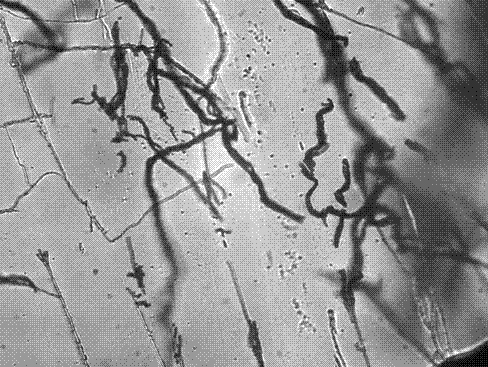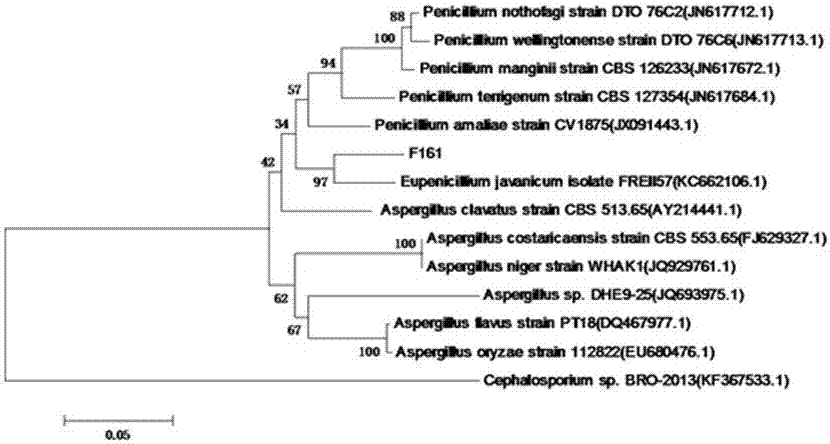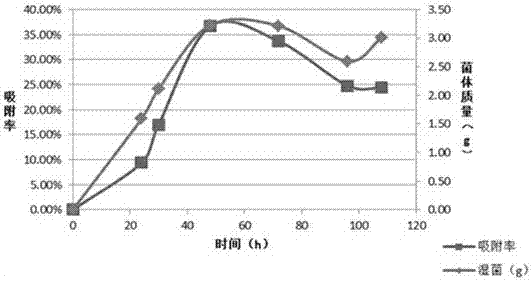A radiation-resistant Penicillium and its application in biological treatment of adsorbed radioactive strontium 90
A biological treatment, penicillium technology, applied to microbial strains and its application in bioadsorption of radionuclides, radiation-resistant Penicillium and its application in radionuclide adsorption, can solve the limitation of the ability to repair radioactively polluted environments, etc. question
- Summary
- Abstract
- Description
- Claims
- Application Information
AI Technical Summary
Problems solved by technology
Method used
Image
Examples
Embodiment 1
[0034] Example 1: Isolation and screening of Penicillium sp. F161 CGMCC NO.8381
[0035] 1. Separation: The radiation-resistant Penicillium sp. used in the present invention was sampled and separated from a radiation-contaminated environment in a certain place in Xinjiang by the Institute of Microbiology, Xinjiang Academy of Agricultural Sciences. According to the collection conditions, a batch of well-growing microbial strains were screened out, and a strain numbered F161 was selected from them.
[0036] Separation steps: According to the gradient dilution method, weigh 10g of soil samples in 90mL sterile physiological saline, and perform gradient dilution after activation at 30°C for 30min. Select 10 -2 、10 -3 、10 -4 The dilutions were spread on the plates of PDA medium respectively, and each treatment was replicated three times, and cultured at 30°C. After the colonies grow out, pick colonies of different shapes, sizes, colors, etc. to streak and inoculate them in the ne...
Embodiment 2
[0043] Example 2: Sequence determination and phylogenetic analysis of Penicillium sp. F161 CGMCC NO.8381
[0044] 1. DNA extraction: the fungal extraction method is as follows:
[0045] (1) 200 mg of bacterial cells were ground with liquid nitrogen, and 3 ml of 3% CTAB extraction buffer was added; placed in a water bath at 65°C for 45 minutes, and centrifuged at 4,000 r / min for 20 minutes at 4°C.
[0046] (2) Transfer the supernatant to a centrifuge tube, add 4 μl of 10 mg / ml protease, incubate at 37°C for 1 h.
[0047] (3) Add 800 μl Tris saturated phenol, shake well, and centrifuge at 13000 r / min for 10 min; take the supernatant.
[0048] (4) Add an equal volume of chloroform / isoamyl alcohol, shake well, and centrifuge at 13000 r / min for 10 min; take the supernatant.
[0049] (5) Add 10 mg / ml RNase, and treat overnight in a water bath at 37°C.
[0050] (6) Add 800 μl of chloroform / isoamyl alcohol, shake well, and centrifuge at 13000 r / min for 10 min; take the supernatant....
Embodiment 3
[0060] Example 3: Radiation resistance of Penicillium sp. F161
[0061] Two conditions must be met for microorganisms to treat radioactive pollution in the environment, that is, they can survive in a radiation environment and have high adsorption selectivity for polluting nuclides. Penicillium F161 used was extracted from radionuclide-contaminated soil. 60 Co radioactive source γ-ray irradiation, the cumulative radiation dose is 10 kGy. By comparing the culture of irradiated samples and non-irradiated samples, it was found that its growth was not affected by irradiation, that is, Penicillium F161 has a strong ability to resist radiation. The radiation properties (gamma radiation) of Penicillium F161 were verified by the method established by Ferreira et al. Bacteria were cultured in PDA liquid medium to the stable stage, centrifuged at 4°C, washed with normal saline, and the suspension concentration in normal saline was controlled at 1×10 7 –10 8 c.f.u / ml, divided into 2ml...
PUM
 Login to View More
Login to View More Abstract
Description
Claims
Application Information
 Login to View More
Login to View More - R&D
- Intellectual Property
- Life Sciences
- Materials
- Tech Scout
- Unparalleled Data Quality
- Higher Quality Content
- 60% Fewer Hallucinations
Browse by: Latest US Patents, China's latest patents, Technical Efficacy Thesaurus, Application Domain, Technology Topic, Popular Technical Reports.
© 2025 PatSnap. All rights reserved.Legal|Privacy policy|Modern Slavery Act Transparency Statement|Sitemap|About US| Contact US: help@patsnap.com



